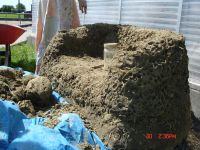
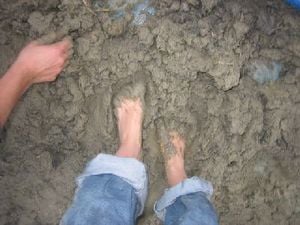
A natural building project creating a cobb bench from natural materials in Arcata, California, in Humboldt County at Bloomfiled Elementary School.
Brief Background Information[edit | edit source]
Preliminary[edit | edit source]
Cobb construction uses earth, the world's most prevalent building material. The word cobb comes from an old English root meaning a lump or rounded mass (from www.cobcottage.com)"Cob" is also an english term meaning mud building, which uses no forms, no bricks and no wooden structures. Cobb building uses hands and feet to mix a ratio of river sand, clay and straw. This mixture is then formed into cobb balls for uses similiar to sculpting with clay.
Origins[edit | edit source]
Earthern construction takes many forms. Some types include adobe, sod, wattle-and-duab, rammed earth and straw-clay. Natural building has existed for over 10,000 years. Every continent has buildings constructed with earthen materials. In the present day, estimates show between thirty-three and fifty percent of the globe's population lives in earthen dwellings.
- Oregon Cobb - The early history of cobb's engish evolution from other techniques of natural building has many twists and turns ranging from the 15th century to current times. Oregon cobb differs from traditional english cobb as in quality of materials and proportions of the mixture.
- Modern day materials - Natural builders hundreds of years ago had access only to low grade dirt materials with little overall clay content with many foreign debris. Cobb builders today have clay providers to deliver earth direct to the site for a low cost. Clay providers offer rich materials that make for sturdy structures. Straw centuries ago was a valuable resource used for animal bedding, thatching and other needs. Fiber, the third element of the cobb mixture, is a material today that is inexpensive and in generous proportion. Using the Oregon technique on the Bloomfield bench produced excellent batches of cobb.
Project Description[edit | edit source]
Materials[edit | edit source]
- Sifted river sand
- Clay
- Straw
- Demolished cement (urbanite)
- Shovels
- Sand Sifters
- Gravel
- Tarps
- Wheel Barrow
- 4 gallon bucket
- Water (garden hose)
Site[edit | edit source]
Bloomfield Elementary School in Arcata, California. We made the bench for the children to enjoy. It is infront of the school green house facing the playground.
How to Make Cobb[edit | edit source]
- Sift the sand (an old screen is great for sifting) and go through the clay to insure that your mix will be free of large particles and earth matter (i.e., rocks, trash, etc.) prior to mixing process.
- You need to figure out the ratios of clay to sand, we used a ratio of 3 parts clay to 5 parts sand, adding as much straw as needed for tensile strength.
- Once you have the ratio go ahead and evenly spread out your sand onto a tarp on the ground.
- Break the clay into pieces and add on top of the existing sand on the tarp.
- Now for the fun...take off your shoes and dance on the clay and sand until it is thoroughly mixed.
- Once the consistency is met, add a layer of straw to the mix and have another dance party on the mix until throughly mixed.
- Now roll up a handful of cobb mix into a ball and toss it back and forth between your hands. Use both hands to pull the ball apart checking for tensile strength by testing the resistance of the cobb mixture.
- You are looking for a mixture that is very hard to pull apart and, that when it is pulled apart, there is a lot of straw showing,insuring that the straw is what is lending itself to the tensile strength of the mixture.
- If needed add more clay it it's too gritty or add more sand if it's to moist and there seems to be mushy qualities to the mix.
- Once consistency of mixture is met, you can start to roll mixture into large balls, which is helpful in applying to the bench.
- Apply the balls to the structure using your fingertips, never patting of smoothing the cobb mix, allowing layers to be added and joined easier with the application of cobb being "natural"(smoothing and patting of the mixture to the structure should not be done,this will lessen the ability of the cobb's adhesive properties to prior cobb sessions or layers of cobb. Cobb will not conjoin with a smooth surface,it needs an uneven, rough, holey surface to join to.)
- Once the structure is made with the cobb then you can go ahead and start to prepare for the clay slip application.
- For the clay slip go ahead and add water to a bucket full of clay and let set sit over night. I let it sit for at least 24 hours for the bench.
- Apply the milky liquid of the water and clay in the bucket to the bench, making sure the clay slip is applied to the entire structure the bench.
- Now you just have to wait for the bench to dry again and once it is dry you can add the linseed oil to the bench.
- The linseed oil is used as a seal for the bench.
- Apply the linseed oil using a paint brush. We applied two coats to the bench, to insure a good seal.
Method and Construction[edit | edit source]
Using the ratio 5 four gallon buckets of river sand to 3 four gallon buckets of clay, these two materials were mixed first using feet on a tarp. When the weather was dry a garden hose was needed to give light water to the clay and the sand for use as a mixing agent. If one is cobbing in the rain, then this watering step is not needed, the sky will provide the moisture. After continous mixing of the clay and sand we tested to make sure the two materials were forming togther. The group used the "taco method" in lifting the sides of the tarp to stir the cobb mix into the center. Performing the lift on each side of the tarp makes mixing many pounds of earth easier. When the sand and clay was properly mixed straw was added to the top surface of the cobb. We applied a thick layering of fiber and then began to mix the cobb with our feet. Mixing cobb with the foot method takes time. Stomping sand and clay is hard work but make certain to take enough time in the mixing step to ensure all the materials have been worked togther. After full blending of the cobb, the completed concoction was formed into softball sized "cobb balls." A cobb line was used from the tarp to the bench where the cobb balls were applied.
-
Testing different ratios of clay to sand for cobb mixture.
-
Digging into to earth to lay foundation.
-
Measuring the depth of hole for foundation.
-
Laying the urbanite pieces and gravel of the foundation.
-
laying the urbanite for the bench with urbanite and gravel
-
Preparing the ingredients to mix the cobb.
-
Mixing the clay and sand together.
-
Testing the tensile strength of the cobb mix before applying to the foundation.
-
A communal assembly line of cobbers with cobb balls in hand, ready to make a bench.
Conclusion[edit | edit source]
After multiple cobbing sessions and adding the cobb to the existing structure, our bench was finally becoming a bench. We added cupholders to each arm rest for asthetical purposes with drain holes angled downwards. Once the bench structure was completed and dried, we applied the clay slip, which consists of clay soaked in water for multiple hours, applying this by hand. Once this was completed and dry we then added layers of linseed oil for the sealing of the bench.
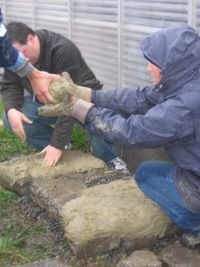

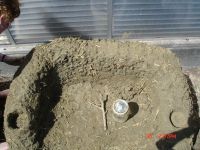
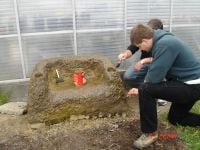
Update July 2007[edit | edit source]
This bench has been badly weathered.
Discussion[edit | edit source]
- Wet Sand Sifting sand that has recieved recent rain is a tough task. The labor time on sifting will increase greatly. If sand has to be picked up wet it is advantageous to wait and cover the sand a few days letting it dry out before the sifting begins. The amount of time saved when sifting dry sand compared to wet sand will be huge. This makes a big difference in a long session of work where sand sifting could of been done with little strength used in about 20 minutes compared to an hour and a half or more of slow going back breaking work. Look for dry river sand when sifting.
- Cobb Construction Uses Cobb is a wonderful medium for projects around the house. Garden walls are a type of natural building that has many functions. Garden walls can be built large or small, long or short, and provide an earthen partition for one's garden that will add an appropriate zing to a backyard area. A number of ideas are possible for garden walls or any type of cobb construction. Not only is cobb practical but an art form as well.
- Wick Foundation Carefull when using large pieces of urbanite. Damage to the fingers is easy to do and painful. Make sure to build the foundation vertically from the surface 10 inches to a foot or more. When building up out of the ground look for clean cut pieces of urbanite to stack on the corners and/or edges that face outward. This will give the project a cleaner look with a lot of polish.
- Finding Clay Working with the Bloomfield project and other cobb builing projects it has been found that locating clay can be a challenging obstical. Good places to find clay remain to be construction sites but these can be hit or miss. While it was not used for this Bloomfield bench project, clay can be found in mass amounts in wooded areas along creek beds. This clay is super rich and has little debris. An accessible location of this type of wood creek site is not easy to find.
- Weather Building in the rain season slows the cobbing process. If a cobb session is done in the rain, watering the cobb mix most likely will not be needed. If rain is prevelant in the drying stages in bewteen cobb sessions more days should be given to allow the previous cobb to fully dry. In wet weather look to wait a week. If the project can be left uncovered with no rain and warm temperature the drying time will be signifigantly less.
- Straw Straw is added by several handfuls to the mix. The mix must be completly mixed before the straw is added. The straw is added to give tensile strength with fiber. Straw works well when added to the mix. Straw is bought usally at grain or feed stores. It can also be found at your local farmer. Straw is usally in bales when purchased.
- Maintaince Throughout the year linseed oil needs to be applied when needed. Linseed oil is usally applied once a year to prevent further cracking. Linseed oil is purchased at most harware stores. Linseed oil is applied with paintbrushes. Linseed oil sometimes needs two coats to ensure the oil has covered the cobb.
Sources[edit | edit source]
- Cobworks.com Your guide to build cob and earthhouses
- Network Productions Creating and disseminating media to help regenerate the earth
- Cob Cottage Company








